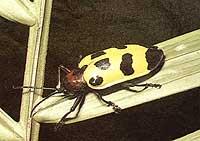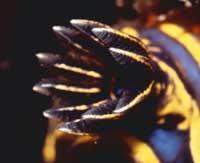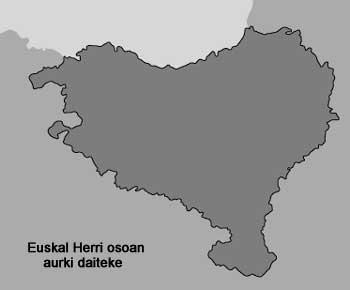The art of deception: camouflage and mimicry
1995/11/01 Zabala Arteaga, Alexander Iturria: Elhuyar aldizkaria
However, many of these adaptations are incomprehensible to us. For example, the polar bear ( Ursus maritimus) is white, but is that color camouflage? Wouldn't it keep the heat better if it were black? Is the colour useful to get closer to the dams? Let us try to give a correct answer to these questions.
Camouflage
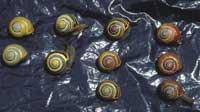
Camouflage is a strategy of confusion with the environment and soundproofing. The objectives of this strategy can be very varied and although prey uses it for defense, predators have adapted it for hunting.
Due to the vegetation, the most common colors of the environment are green and brown, so it is not surprising that the most common camouflage colors are based on them. However, there are areas of special colors, known spiders that camouflage properly in brightly colored flowers. It is curious, on the other hand, that no green mammals are known, although for some who are prey of birds this color is very appropriate. It seems that mammals cannot get the green coat. However, lazy (Bradipodidae fam.) on hair grow symbiotic algae that facilitate camouflage.
In the analysis of camouflage it must be taken into account that animals use different mechanisms of perception. While some predators hunt with the ear or smell, others use sight. In addition, despite talking about sight, there are different ways of seeing. Although insects, fish and birds distinguish colors, most mammals, except primates, see them in black and white. On the other hand, among animals that see in color, not all distinguish the same colors; bees, for example, see UV invisible to us. Therefore, the suitability of camouflage must be measured according to the development of the sensory organs of its potential predators.
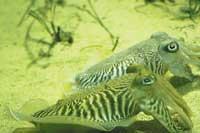
To demonstrate the suitability of camouflage, studies with polymorphic species with more than one camouflage pattern are very appropriate. If in a cage of brown and green grasshoppers we release a bird that feeds on them, first it has been observed that it eats the less camouflaged. However, in the same cage, the satellite feeds on the same proportion of two-colored grasshoppers. The difference lies in the type of predation, as the bird hunts through sight and mole through smell. Therefore, the camouflage color of the grasshopper serves to protect itself from the bird, but not from the mole.
After several experiments, it is confirmed that when there are many camouflaged dams, although the color of the camouflage is adequate, the dams are trained in the capture of these species. It may be thought that predators first capture the most visionary hunting species, but when missing they learn to find camouflaged prey. In these cases, one of the reasons for explaining the survival of polyform species with different camouflage models is their advantage.
Polymorphism for concealment
As mentioned above, green and brown predominate in nature, but their proportion varies throughout the year. In addition, sometimes snowfalls turn the environment into white, so animals must face these color changes. Some hibernate in winter to avoid food shortages and cold, but there are also active animals in winter. These, in order to continue hiding, must face the change of color of the medium and in this case polymorphism is a perfect strategy.
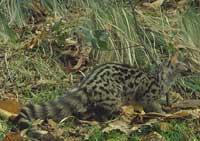
The Cepaea nemoralis marrasquilla of our pastures is polymorphic and its shell can be yellow, pink or brown, without bands or with a quantity of one to five bands. Until 1940 it was considered that this variability was a consequence of mutations, but as has been observed later, the temperature causes changes in the colors of the shell, so at high temperatures are more abundant the brown color and the drawings with bands. Apparently, this polymorphism is due to the selective hunting carried out by their prey ( Turdus merula) and their foxes ( Turdus philomelos).
The chrysalis of many insects use a periodic polymorphism to combat the color change of the environment. In spring they are green and brown in summer and autumn. It seems that in different species there are mechanisms to achieve the most suitable color pupa in the middle. Some pupae use light to detect the color of the medium, developing in them the green pupa and in the blue the brown. When the vegetation is green, the blue light is absorbed and only passes the yellow light. In other species, the roughness of the substrate is the one that determines the color of the pupa, adopting a brown color in the rough roots (trunk and branches) and green in the dry roots (leaves). Finally, those that detect the humidity of the wind and in wet times, that is, when the vegetation is green, are green and in dry brown times.
The white partridge (Lagopus mutus) also has a brown plumage in summer, but when the snow covers everything in winter, the plumage becomes white. This gradual color change is regulated by the very duration of the winter and when the day has less than 12 light hours, develops the white plumage.
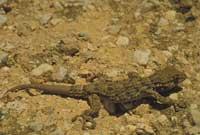
Among the mammals there are also species that change color, as the armiño ( Mustela erminea) in summer presents a brown and white coat in winter. In these animals the change of hair color is genetically regulated and the cause of change is temperature. In the cases of the Virgin and Polar Bear, the white coat is appropriate to approach the prey hidden in the snow. The polar bear, under white fur, has a black leather and according to research, white wool leads the heat of the sun to black skin. In this way, the bear manages to absorb as much heat as if it were black and be camouflaged. Among the mammals is common the change of hair that occurs throughout the year: some, such as the deer ( Cevus elaphus) or the fox ( Vulpes vulpes vulpes), alter the tone of the hair, although they do not get an appreciable change of color of the yerbinado.
There are also animals able to carry out a rapid change of color, among which the chameleon ( Chamaeleo chamaeleon) stands out. Although more unknown, many river fish can take the colors of the substrate in which they live, as is the case of trout ( Psalm trutta). On the other hand, most marine fish have a whitish belly, so that during swimming they are almost invisible from the bottom, as they eliminate the shadow that generates the light coming from above.
In many birds sexual dimorphism appears: in most cases the male is brightly colored and the female camouflage. In these cases, the striking colours of the male reduce the concealment capacity. All this leads us to think again of many questions: why become a visionary? Why have you kept that color so inappropriate for concealment throughout evolution? Why is there polymorphism in this case?...
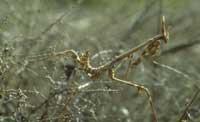
There are reasons why these colors have been preserved throughout evolution. In these species the females are paired with the most visionary, so the presence of bright colors is a risk to assume for obtaining the female. Due to this “taste” of the females, the most visionary are the ones who have the most success when breeding. Therefore, despite living less, the next generation passes a higher proportion of its genes. Therefore, despite having a vivid color, the characteristics have evolved. To explain this fondness of females it is usually said that live tail males are well fed and healthy. Females seek these characteristics with the certainty that the breeding will proceed and a healthy generation will be achieved. In the case of females, however, the camouflage color is necessary, since in the breeding phase they would endanger the cabin if they were easily observable.
Use of camouflage
Camouflage is a general defense system for many adult beings, but it sharpens at high risk. Thus, both the young specimens of many birds and the young of many mammals appear perfectly camouflaged. For example, in the stair snake ( Elaphe scalaris) young people have a camouflage color more suitable than adults.
There are many predators that camouflage for hunting, spotted (Mantidae fam. ), the camouflage faculties of sepia ( Sepia officinalis), lion ( Panthera leo), catagineta ( Genetta genetta), etc. are well known. Although some have uniform camouflage, sepia or catagineta have a coloration decorated with dots and stripes, that is, a disruptive coloration. In addition to the disruptive coloration, rough bodies appear that help other animals to camouflage, such as the common salamanquesa (Tarentola mauritanica).
Mimicry
Mimicry is shaping something or someone. Sometimes they adopt the form of objects that do not serve to feed and thus get protection. On other occasions, they acquire the appearance of edible things to facilitate hunting.
Among the animals that use mimicry for predation is the sea fish ( Lophius piscatorius). It is very well camouflaged and has a very long spine that mimics rabies at the end of the back. It attracts the little fish by placing the false Amuski in front of the mouth and devours them with the current generated when opening the mouth.
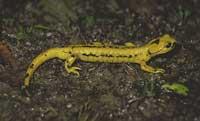
Mimicry is used not only for capture, but also for protection. That is the goal of homeotyping, that is, hiding by imitating non-edible objects in the environment. There are many insects that imitate sticks or leaves. Some butterflies and spiders also have the ability to mimic bird droppings. This defensive system appears in the case of the Asian anuro Megophrys carinensis, which is defended by imitating stones in plant species of the African genus Lithops or imitating leaves.
Some animals have protectors like poison or bad taste and use bright colors to express it. These colors are called aposematics and are based on the colors red, orange, yellow, black or their combinations. Colors indicate a dangerous character and predators learn to put the animals of those colors at peace. The ruin of our forests ( Salamander salamander) presents an aposematic yellow-black coloration that indicates that it is able to defend itself from the poison produced by its glands. Some animals defend themselves by imitating others with that aposematic coloring. Bees (Apoidea fam.) and beekeeping (Vespidae fam.) have punctures and warn of this danger by adorning with bands of aposematic color; some flies (Conopidae fam.) defend themselves by imitating that.
Animals with aposematic coloration are not attacked by their predators, so other animals imitate them, that is, they become mists of the aposemans. Two types of aposematism mimicry are known: Mimetismo Bates and mimetismo Muller.
Bates mimicry is defined as the appearance of an aposematic and dangerous animal for the protection of a living being that is not dangerous, and Muller mimicry, the fact that two species have the same appearance, both dangerous. The risky aspect that the predator has learned can be very beneficial, since in this way the meaning of aposematism is reinforced.
The means of defense are not insurmountable
Camouflage and mimicry do not completely protect the animal: the predator can find a camouflaged animal or a hungry predator can try to eat animals of aposematic coloration, especially when there is much mimicry. On the other hand, the most feared predator may have to defend himself at some point in his life. The puppies of the Savannah owner lions, for example, in the absence of their father's protection, could be lost to the attack of an adult male.
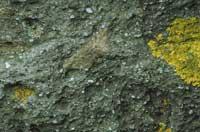
To carry out any protection strategy, behavior is very important. For example, the green color is not enough if it then tends to be at the root of other colors. Camouflage color, mimicry, aposematism, behavior and other protective strategies have been consolidated through natural selections to the extent of current development as a result of the long evolution. However, with defense systems the ways to overcome them evolve, so there is no total protection. All living beings, due to the continuous development of the means of defense, have an impulsive part of life that tries to resolve throughout evolution.
Although protection strategies are increasingly appropriate, it should not be forgotten that they are a direct consequence of the selective hunting pressure exerted by dams. In this issue, evolution itself has the last word. Let us, therefore, do our job.

Gai honi buruzko eduki gehiago
Elhuyarrek garatutako teknologia



